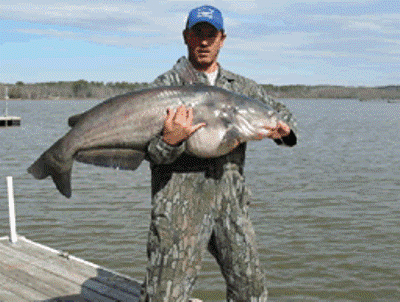
Even with North Carolina squeezed in the bitter two-fisted grip of winter, anglers can pay their money and take their choices of catfish — blues, flatheads or channels — at Lake Norman, said guide Jerry Neeley of Bessemer City.
“January’s a good month for catfish at Lake Norman, especially big blues,” said Neeley (704-629-9288, jerry@carolinasfishing.com). “February’s good, too.”
The nice thing about fishing for Lake Norman catfish is the technique — it’s almost the same for all three species, except for baits.
“I like to troll with Santee rigs,” he said.
A Santee rig, with a 1- to 2-ounce weight, is basically a knockoff of a bass angler’s Carolina rig, designed to get baits (live or cut) to the bottom quickly. But a small crappie float placed about 8 inches from the hook keeps baits (and hooks) off the bottom. A Santee rig’s weight also is different from the barrel sinkers used for Carolina rigs. It’s usually a parachute weight (a piece of parachute cord with buckshot-size lead balls sewn inside), sometimes called a “slinky.” Tied to a swivel at the start of the leader about 18 inches from the bait and hook, a 6- to 8-inch-long slinky weight will slide over bottom structure instead of hanging up, a necessity when slow-trolling on the bottom for catfish.
“I use cut bait, shad, crappie or bream, to fish for channel cats and blue cats and drift less than .8 mph with my trolling motor and let the wind move me some,” Neeley said. “If I’m fishing for flatheads, I usually anchor and put out live baits. You hardly ever catch a flathead using dead baits.”
Neeley pointed out anglers who use crappie or bream as catfish baits must catch them with hook and line, not cast nets. Crappie also must be legal keeper size (8 inches).
“Just fillet the sides for bait and keep the bodies intact so you can show them to a (game) warden if you get checked,” he said.
Neeley usually drifts six rods for catfish with the butt ends stuck in rod holders. Catfish usually hook themselves on Neeley’s circle hooks when they swim off with a bait. All an angler has to do is pick up the rod, apply pressure and begin reeling. He varies his hook sizes, using smaller ones for channel cats and large ones for blue catfish.
“When I drift with cut baits I put out half-a-spool of an Abu-Garcia 6000 or 6500 reel behind the boat,” he said. “If you fish too close to the boat, catfish don’t seem to bite as well.”
Neeley likes to take winter catfish anglers to the backs of creeks and drift baits 30- to 40-feet deep along channels toward the creeks mouths. Two of his favorite Lake Norman catfish creeks are Davidson and Little.
“We’ve been catching some nice-size blue cats,” he said.





Be the first to comment